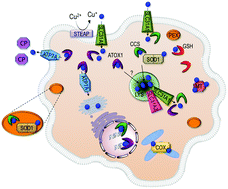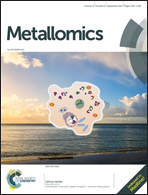Orchestration of dynamic copper navigation – new and missing pieces
Abstract
A general principle in all cells in the body is that an essential metal – here copper – is taken up at the plasma membrane, directed through cellular compartments for use in specific enzymes and pathways, stored in specific scavenging molecules if in surplus, and finally expelled from the cells. Here we attempt to provide a critical view on key concepts involved in copper transfer across membranes and through compartments in the human body. The focus of this review is on the influence of bioinorganic and thermodynamic rules on the flow in cellular copper networks. Transition of copper from one oxidation state to another will often lead to errant electrons that are highly reactive and prone to form radicals and reactive oxygen or nitrogen species (ROS and RNS). Strict control of potentially toxic oxidative species is an important part of understanding the edge of human copper metabolism. The present review critically covers translocation across simple and complex membranes as well as extracellular and intracellular copper routing. We discuss in depth four tissues with polarized cell barriers – the gut, liver, kidneys, and brain – to illustrate the similarities and differences in transcellular transfer. Copper chaperoning, buffering and binding dynamics to guide the metal to different sites are also covered, while individual molecular interaction kinetics are not detailed. Sorting and targeting mechanisms and principles crucial for correct localisation will also be touched upon.

- This article is part of the themed collection: Recent Review Articles


 Please wait while we load your content...
Please wait while we load your content...